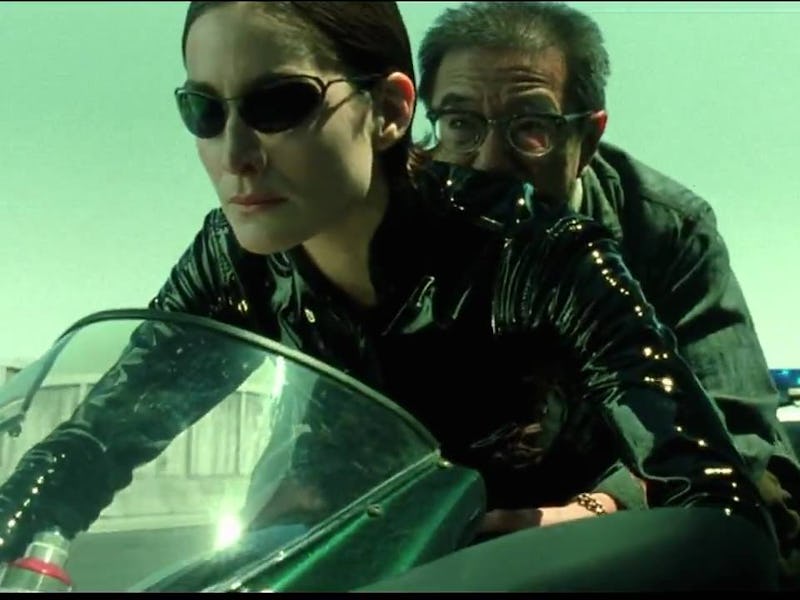You need to watch the most dazzling sci-fi sequel on HBO Max ASAP
It's time to go back down the rabbit hole.

In a modern movie trilogy, the sequel has unique responsibilities. It must neither truly begin nor end a story, especially in as trilogy-heavy a town as Hollywood.
Instead, the second entry in a series offers partial resolution, with new problems being established as old ones are solved. Additionally, it must offer enough novelty value to justify its own existence. But being pulled in many directions can make it hard for a sequel to stand out.
At times, 2003’s The Matrix Reloaded struggles to strike a balance between what came before and what was still in the works, mainly in its first and final stretches. But sandwiched in between those rough patches is a terrific movie that presents the heart of what Lana and Lilly Wachowski were out to accomplish with their original trilogy: an action saga with philosophical heft, that moved between jaw-dropping fight scenes and questions of control.
Keanu Reeves in The Matrix Reloaded.
Major revelations abound in The Matrix Reloaded. Neo (Keanu Reeves) explores the answers behind the prophecies told to him by Morpheus (Lawrence Fishburne), who once told him that he was The One, able to fly, stop bullets, and ultimately liberate humanity from the machines.
As opposed to the first film’s revelation that the world as we knew it was a lie, The Matrix Reloaded uncovers further tensions within the machine. That world now feels more divided into clear sides—there’s The Matrix, where everything has a sickly green tinge, and then there’s the city of Zion, the real world.
The audience learns a little about Zion as a community, including that it’s run by a council of elders. The Wachowskis are careful to show that the military follows the commands of the government. But beyond that, they are more interested in showing Zion as a place where life is celebrated, during a fantastic (and deeply misunderstood) rave sequence.
The rave scene in The Matrix Reloaded.
Often derided as “insane,” “awkward,” and “silly,” the rave scene is crucial. As with other parts of Reloaded, it’s related directly to the first movie. There. the Wachowskis depicted the struggle for freedom as a difficult and impoverished one, with options so dire that Joe Pantoliano’s character switched sides to get a decent steak.
With the rave sequence, the Wachowskis wanted to show that, even though it’s hard-won, freedom is worth fighting for. Even though Link (Harold Perrinu) and Zee (Nona Gaye, who took over the role after Aaliyah’s passing) had fought previously, they unite at this rave out of love. Being liberated from the Matrix isn’t just about becoming a superhero; it also means a man can make passionate love to a person he adores. Love, dancing and sex are to be celebrated, Reloaded says with its rave scene, and the intimacy between its dancers is authentic.
Two massive posses show up in Reloaded: the ravers, and the army of Agent Smith’s carbon copies. The Wachowskis understood that the world needed 100 more Hugo Weavings, and visual effects supervisor John Gaeta helped them get there. Once he heard the Wachowskis’ vision, he realized that his work on bullet-time was nothing in comparison to this next challenge. Talking to Wired, Gaeta said that:
“My job has nothing to do with making zingers. The point is not to knock you over with a visual trick. The point is to be able to construct events that are so complex, in terms of what human bodies need to do, that the total 'effect' is impossible choreography. 'My God! It looks real, but it just can't be.”
Monica Bellucci in The Matrix Reloaded.
The Matrix Reloaded is up to this task. Some of its CGI looks dated, sure, but its combination of practical choreography and visual effects can still feel stunning. With Neo armed only with a pole against an ever-growing mob of clones, his exaggerated powers feel just real enough to ground you in the action.
The other large action sequences are equally ambitious. Carrie-Anne Moss told IGN that she “trained for months” and pushed through a “major fear” of motorcycles to nail her scene on a Ducati 996. Co-passenger The Keymaker (Randall Duk Kim) made sure to “commend her for her great courage” in an interview with EW.
Plenty of characters stand out in The Matrix Reloaded. The Merovingian (Lambert Wilson) and his wife Persephone (Monica Bellucci) offer a number of horny distractions from the story, and then there’s the matter of those ghostly Twins (Neil and Adrian Rayment).
However, several other characters fared less well, like the forgettable Councillor Hamann (Anthony Zerbe) and Commander Lock (Harry Lennix), who seemed to exist mainly so the Wachowskis could execute more philosophical references.
Some elements of Reloaded, like its cliffhanger ending, prevent the movie from fully standing on its own. Choices are made, of course, but the audience has no real understanding of what those choices mean, given that they matter more to what comes next.
What I remember most about watching The Matrix Reloaded in theaters was The Architect’s (Helmut Bakaitis) monologue near the end, telling Neo that he’s the sixth iteration of The One . “Oh my god,” I kept thinking to myself, “this is it. We’re inside the Matrix.”
Although I could barely understand a word, I felt enveloped by its world. At its best, The Matrix Reloaded feels like a rich text that needs to be studied over and over again.
The Matrix Reloaded is now streaming on HBO Max.
This article was originally published on